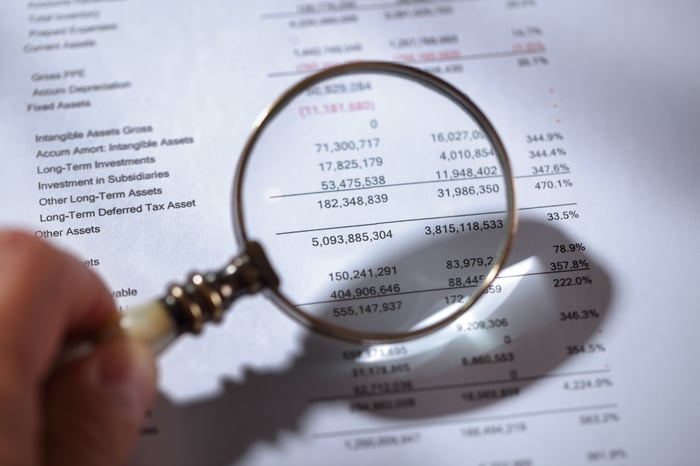The legal-marijuana industry is growing like a weed, and marijuana-stock investors simply can't help taking notice.
Last year, according to cannabis research firm ArcView, North American legal-pot sales grew by 34% to $6.9 billion. This, however, is just the tip of the iceberg. You see, ArcView also estimated that $46.4 billion in North American weed sales last year was conducted on the black market, meaning there's a very large multi-year opportunity for these consumers to be brought into legal channels. This opportunity, along with organic growth from ongoing state- and country-level expansion, has fueled investors' interest in marijuana stocks.

Image source: Getty Images.
A recent screening of the 13 largest pot stocks found that just one was lower over the trailing-12-month period. Conversely, two-thirds of those that were higher had risen by a minimum of 100%. In fact, the average pot stock has increased in value by better than 300% over the trailing year.
Say hello to a pot stock that's up 2,500% in a year
Of course, one company has been critical to skewing those results: Axim Biotechnologies (AXIM 5.88%). Axim is a clinical-stage drug developer that has absolutely been on fire since receiving an investment from Medical Marijuana, Inc. (MJNA -20.00%) in October 2016. Shares of the drugmaker are up (drum roll)... 2,500%. That's not a typo. At one point its stock had risen more than 5,700% before profit-taking took hold.
Why such bullishness? Aside from the inherent optimism surrounding cannabis sales, Axim presents a very diverse and large pipeline to investors. The company has 15 proposed drug/indication trials listed on its website, a small handful of which have moved into early-stage studies.
In particular, there's a lot of optimism surrounding Axim's delivery mechanism: cannabinoid-based chewing gum. Allowing the user to absorb cannabidiol, or another cannabinoid, through the chewing-gum process can allow for a controlled release. Doing so could result in lower doses needed to effect positive biologic change.
However, in spite of Axim's truly phenomenal returns, it has two major red flags that should have investors very concerned.

Image source: Getty Images.
Axim is a "going concern"
First, let's take a gander at its latest quarterly report filing with the Securities and Exchange Commission. On page 19 of the SEC report you'll find the dreaded "going concern" note, which reads as such:
As shown in the unaudited condensed consolidated financial statements, the company has negative working capital of $2,130,130, has an accumulated deficit of $18,593,796, has cash used in operating activities of continuing operations $580,922, and presently does not have the resources to accomplish its objectives during the next twelve months. These conditions raise substantial doubt about the ability of the company to continue as a going concern.
The first thing that stands out is the company's cash on hand: $580,922. This isn't in millions, folks. Axim is planning to run 15 clinical studies, plus run its nutraceutical business studies, too, and it has less than $581,000 in its coffers. That may not even be enough to successfully get a single clinical trial through phase 1, let alone 15.
At the same time, because the company is so dependent on its clinical pipeline, it has virtually no revenue. Sales in the latest quarter tallied just $18,620. The company spent more than twice as much on the costs to sell its products ($38,930) and also spent more servicing the interest on its debt ($24,560). Thus, it's worked up an accumulated deficit (an aggregate of its net losses since inception) of nearly $18.6 million, and it currently has negative working capital. The only reasonable way Axim can raise money is either to dilute shareholders with a stock offering or to take on more debt, and neither method is particularly appealing from the perspective of its shareholders.
This going concern note and financial data should be more than enough to scare investors away from Axim – but there's more.

Image source: Getty Images.
Axim paid a company to promote its stock
In mid-May, investment firm SeeThruEquity initiated coverage on Axim at seemingly the perfect time. Shares of the company had fallen to nearly $8 from its 52-week high of nearly $20, but they zoomed quickly higher after the firm initiated Axim with a price target of $17. SeeThruEquity pointed to the opportunity for CanChew and MedChewRx in a variety of broad indications as its reasoning behind the optimistic price target.
However, this Fool dug a bit deeper and uncovered something very important in SeeThruEquity's coverage disclosure:
The company featured in this report paid SeeThruEquity its standard fee described below for distributing a press release on this report. Such compensation is received on the basis of a fixed fee and made without regard to the opinions and conclusions in its research reports.
In other words, Axim can't control what SeeThruEquity says about its company, but it nevertheless paid SeeThruEquity to promote its findings. To be crystal clear, paid stock promotion is a legal practice as long as it's disclosed, which SeeThruEquity did do. However, paid stock promotion is also something the Wall Street community tends to frown upon, since there's the perception of little objectivity on the part of the investment firm.

Image source: Getty Images.
The bottom line
Essentially, investors have a company valued at $441 million with negative working capital, very little cash on hand, and virtually no clinical evidence that its studies will be a success. There are also no guarantees that it has a means to get the funding needed to run its studies.
At the same time, Axim could wind up being a boon or bust for Medical Marijuana, Inc.'s shareholders. Medical Marijuana currently holds almost 22.7 million shares of Axim, which it's up significantly on. If the company were to sell its shares, it could potentially help fund Axim's research with its profits, but it could also crater Axim's stock. After all, we're talking about 43% of Axim's outstanding shares.
My suspicion is the two are tied at the hip, which makes Medical Marijuana just as a much of a stock to avoid as Axim Biotechnologies at the moment.





